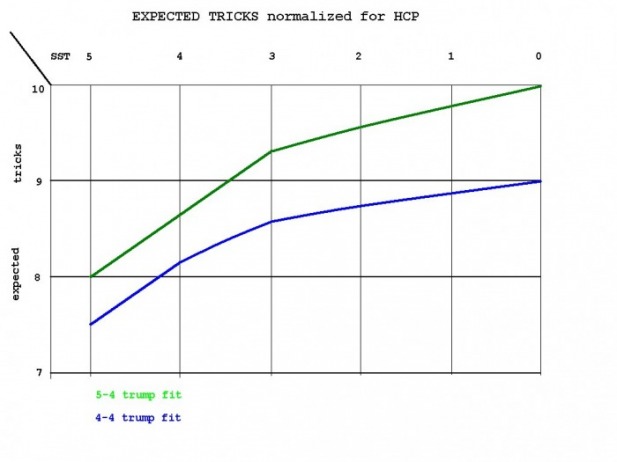 jogs, on 2016-August-12, 08:08, said:
jogs, on 2016-August-12, 08:08, said:
Hasn't this ever happened to you? 1NT+2. But you were in 3NT, it would be 3NT-1. Defenders would cash the setting trick.
Yes... the datafile indeed does indicate the opposite...
i.e. with a given combined HCP-strength [22-25],
you are
more likely to score 9+tricks if you
bid 3NT, than in if you do not.
Outcome:
When both hands are 4333/4432/5332 and the pair ends up in an NT-contract:
- if they have 25 HCP and the contract is 1NT, they score at least 9 tricks in 57.20% of the cases (6913 samples)
- if they have 25 HCP and the contract is 2NT, they score at least 9 tricks in 55.48% of the cases (5056 samples)
- if they have 25 HCP and the contract is 3NT, they score at least 9 tricks in 62.28% of the cases (61179 samples)
- if they have 25 HCP and the contract is 4+NT, they score at least 9 tricks in 56.75% of the cases (289 samples)
- if they have 24 HCP and the contract is 1NT, they score at least 9 tricks in 42.87% of the cases (16882 samples)
- if they have 24 HCP and the contract is 2NT, they score at least 9 tricks in 43.10% of the cases (12421 samples)
- if they have 24 HCP and the contract is 3NT, they score at least 9 tricks in 49.31% of the cases (47500 samples)
- if they have 24 HCP and the contract is 4+NT, they score at least 9 tricks in 46.95% of the cases (164 samples)
- if they have 23 HCP and the contract is 1NT, they score at least 9 tricks in 29.67% of the cases (29047 samples)
- if they have 23 HCP and the contract is 2NT, they score at least 9 tricks in 30.60% of the cases (15530 samples)
- if they have 23 HCP and the contract is 3NT, they score at least 9 tricks in 36.44% of the cases (25448 samples)
- if they have 23 HCP and the contract is 4+NT, they score at least 9 tricks in 29.17% of the cases (96 samples)
- if they have 22 HCP and the contract is 1NT, they score at least 9 tricks in 18.35% of the cases (35317 samples)
- if they have 22 HCP and the contract is 2NT, they score at least 9 tricks in 21.02% of the cases (10307 samples)
- if they have 22 HCP and the contract is 3NT, they score at least 9 tricks in 24.61% of the cases (10829 samples)
- if they have 22 HCP and the contract is 4+NT, they score at least 9 tricks in 18.52% of the cases (54 samples)
(4+NT means 4NT or higher NT-contract)
Not very surprising, really, since overall, declarer has a much better picture of the deal and his risks/chances and knows what he is doing, than defenders.
Another point of interest, perhaps, is that in this data-sample, with 24HCP and two balanced hands,
the players are
more likely to end up in 3NT than an NT-partscore (47500 instances vs 29303 = 62% vs 38%)
 Stephen Tu, on 2016-August-11, 15:36, said:
Stephen Tu, on 2016-August-11, 15:36, said:
 Help
Help



